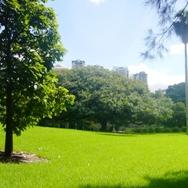Level of Significance
- File
- Local
- Regional
- State
- National
Age (approx)
50yrsTrees
1Diameter
0.9mHeight - 16m


Details
- Landscape (Social)
- Contemporary association (Social)
- Park/Garden/Town (Historic)
- Person/Group/Institution (Historic)
- Attractive (Aesthetic)
Statement of Significance
The site of Brisbane City Botanic Gardens was selected as a public garden in 1828 by New South Wales Colonial Botanist Charles Fraser, three years after the establishment of the European settlement. Originally the garden was planted with food crops to feed the convicts. In 1855, a portion of the land was declared a 'botanic reserve' and Walter Hill was appointed as curator. The Queensland Heritage Register describes the Brisbane City Botanic Gardens as 'the most significant, non-aboriginal cultural landscape in Queensland having a continuous horticultural history since 1828, without any significant loss of land area or change in use over time.' It incorporates Brisbane's most mature gardens and features many rare and unusual species of plants. Curator Harold Caulfield asked Ross McKinnon to plant this tree on 18 September 1972 to commemorate Ross’s first day 'on-the-job' as the Botanic Gardens Supervisor to assist with its redevelopment. Ross McKinnon has continued his work with the City Botanic Gardens for the last 39 years, and in 2012 was continuing as curator of the Brisbane Botanic Gardens Mt Coot-tha.
Having a wide spreading shady canopy and positioned centrally on an open lawn, this tree contributes significantly to the heritage garden's landscape and its shade is a popular area for the community using the gardens. It is an extremely attractive, well-balanced tree and is associated with Ross McKinnon, who in 2014 celebrated 42 years of service with the Brisbane Botanic Gardens, the last 30 years as Curator-in-Charge.
The tree is located in the middle of the open lawn in front of the former curator's cottage.

